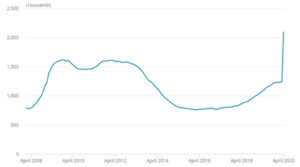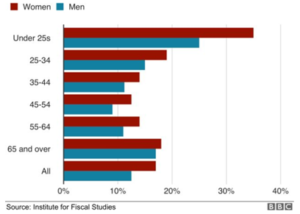A supply chain approach to ending the lockdown
The PM’s recent address to the nation and the media response, highlights the complex challenges we face. We need to get the economy moving again but we can’t risk people’s lives and we need to prevent the NHS from running out of capacity. The latest economic indicators show the level of unemployment is rising dramatically so we need to act now, even though we still don’t have a vaccine nor therapeutic treatments available.
Figure 10: UK claimant Count level increased by 69.1% in April 2022
UK Claimant Count, seasonally adjusted, between January 2008 and April 2022

An impossible conundrum? Not necessarily. A recent University of Edinburgh study caught my attention because it took an approach that resonates with my work in supply chain management. Recent ‘shortages’ in loo rolls and pasta have shown how fragile our supply chains can be and the ‘stay home, save lives, protect the NHS’ focused on the fear that limited resources would quickly be overrun.
In the supply chain world, it’s all about ‘resource management’ – flattening the curve to ease pressure on the NHS – and ‘demand management’, i.e. managing the number of people who need to go to hospital. Our focus is on the ‘flow’ – we want to achieve maximum flow of economic activity whilst minimising the flow of people through the available capacity, hospitals, so that everyone who needs treatment can get it.
Gaining market insight
In supply chain management we often find solutions by segmenting the market, analysing the data to understand which products are selling in what numbers where, what the demand profiles look like and therefore, how best to serve a particular segment. We don’t supply the same number of each product to each retailer – that clearly doesn’t make sense. We’d end up with too much stock in some locations and shortages elsewhere.
Segmentation is key and that’s what the University of Edinburgh report shows. Prof. Sir David Spiegelhalter, one of the country’s leading statisticians and a government adviser, pointed out that the risk of Covid-19 to anyone under 25 was “trivial”. In the 45-64 age group the risk is slightly higher at 3,000 deaths according to the Organisation for National Statistics (ONS). Researchers at Stanford University agree with this and have said deaths in anyone under 65 without a pre-existing illness are “remarkably uncommon”.
But from an economic point of view it is the younger, healthier proportion of society who are suffering the most and also the group most likely to suffer the long-term consequences of the recession. They are the group who need to get back to work.
Younger workers are most affected by UK lockdown
Percentage of employees working in shutdown sectors

A strategy of segmenting and shielding
The proposed strategy is to segment the population into different risk groups based on a person’s medical history and potential healthcare needs – young healthy adults and children can be given greater freedom whilst the most vulnerable groups are protected. Lockdown restrictions could be eased for most people, as long as sufficient measures stay in place to keep transmission rates low and control the number of hospital cases. These would include self-isolation of people with Covid-19, quarantining affected households, contact tracing and voluntary social distancing.
The most vulnerable – the elderly and those with underlying medical conditions – would still need to be shielded from contact with anyone potentially infected with the virus.
“Segmentation and shielding recognises that, although social distancing impacts on the whole of society, the public health burden of Covid-19 is concentrated in a subset of vulnerable people. By targeting protection to those that need it most, the strategy helps to ensure that the health system is not overwhelmed by severe cases, while giving policy makers greater leeway to partially relax social distancing measures for the majority of the population.”
Mark Woolhouse, Professor of Infectious Disease Epidemiology, University of Edinburgh
This strategy would enable us to allow healthy people under 45 to get out into the world and start the economy moving, in every way. 45-65 year olds would need to take a slower approach, considering their individual health condition and continue to work from home for a while. Anyone over 65 needs be very cautious, and need to be shielded until treatments are available, especially those with an underlying health condition, but this age group are typically retired and are not as important to opening up businesses, so the focus can be on quality of life without risking catching the virus. The key is using the data, contacting people and shielding the vulnerable whilst allowing the majority to get our economy and their lives moving forward again.
Supply chains have made the headlines from the start of this crisis, so maybe some of the thinking in this area, use of data and analysis, could help to get the economy moving, whilst protecting the NHS and ensuring if people do need healthcare, there is still capacity available to support them.



